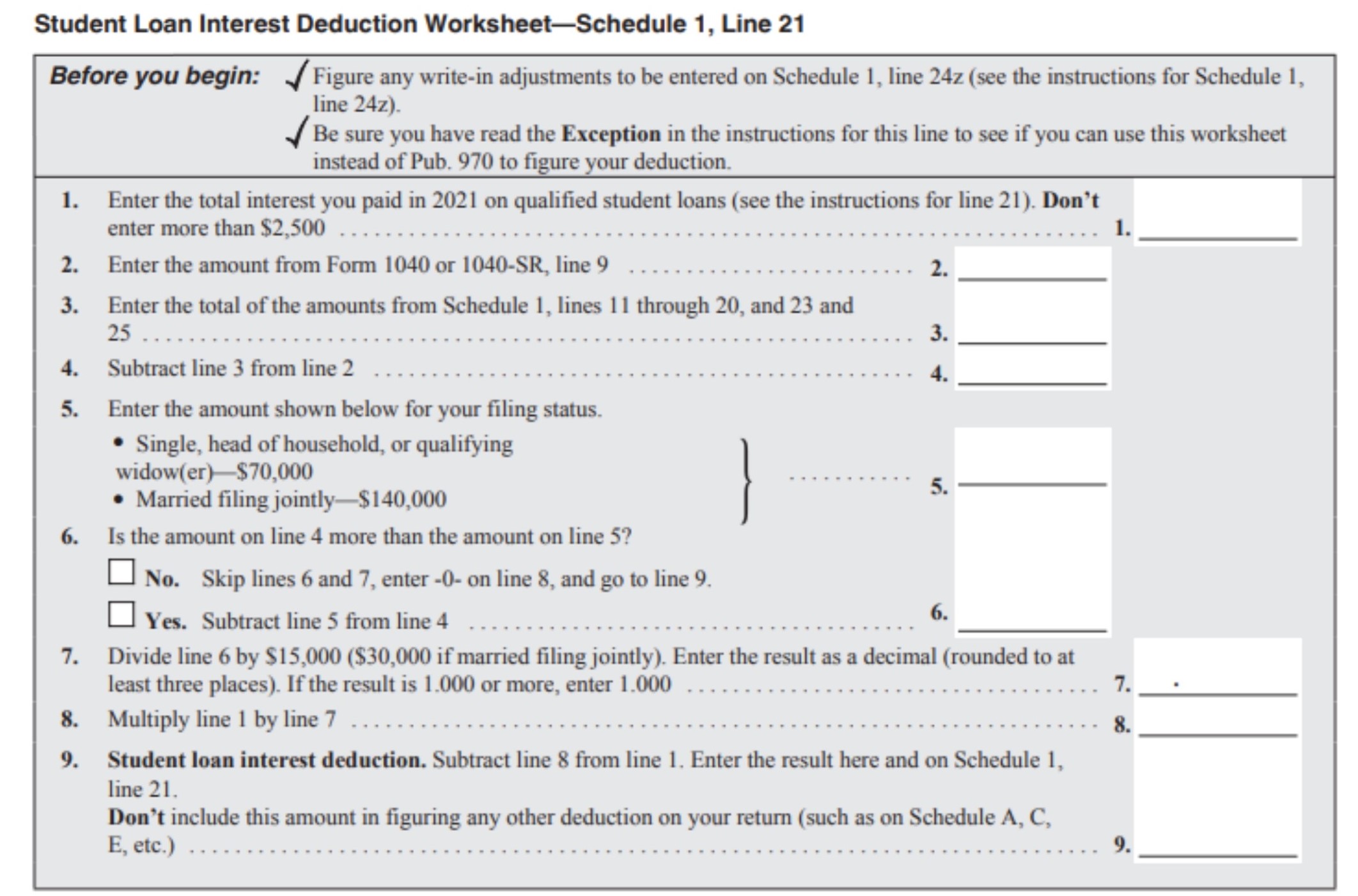The student loan interest deduction may help reduce your taxable income by up to $2,500. Since it’s an above-the-line deduction, you don’t have to itemize to take this tax break. There are, however, income restrictions that could reduce or eliminate your deduction amount. Additionally, other eligibility requirements must be met. To verify your eligibility and learn how to claim this deduction on your tax return, keep reading.
Student Loan Interest Deduction Eligibility
You can take the student loan interest deduction if your modified adjusted gross income (MAGI) is less than the annual limit for your filing status and all of the following apply:
- You paid interest on a qualified student loan during the tax year;
- You are legally obligated to pay interest on a qualified student loan;
- Your tax filing status isn’t married filing separately; and
- You (or your spouse, if filing jointly) can’t be claimed as a dependent on someone else’s tax return.
For the 2021 tax year, the deduction amount starts to phase out once your MAGI reaches $70,000 ($140,000 married filing jointly). If your MAGI exceeds $85,000 ($170,000 married filing jointly), you’re ineligible for the student loan interest deduction.
What’s Considered a Qualified Student Loan?
Interest paid on a private or federal student loan qualifies for the deduction if the loan was used to pay qualified educational expenses for you, your spouse, or your dependent at an eligible school. The loan must also be for an academic term and the eligible student must be enrolled at least half-time.
This means that student loans (in your name) used to help your child pay for college, including Parent PLUS loans, are eligible for the student loan interest deduction. If you’re making payments on loans under your child’s name, however, you can’t deduct the interest on your return. Your child, if claimed as a dependent on your return, would also be ineligible for the deduction. Loans provided by employers or your relatives do not qualify for the student loan interest deduction.
Accredited post-secondary public, private, and non-profit institutions are considered eligible schools. To verify a college or university is an eligible institution, refer to the Database of Accredited Post-Secondary Institutions and Programs or the Federal Student loan Program List.
Qualified Educational Expenses
For the student loan interest deduction, qualified educational expenses may include amounts paid for any of the following items:
- Tuition and fees
- Room and board (living expenses)
- Books and supplies
- Equipment (computers, calculators, etc.)
- Other necessary expenses (such as transportation)
Room and board expenses may not exceed the greater of the allowance determined by the eligible institution or the actual amount charged (if the student is living in accommodations owned/operated by the eligible institution).
How to Claim The Student Loan Interest Deduction
If you meet the eligibility and income requirements, claiming the student loan interest deduction is fairly easy. Your tax preparation software will calculate the amount for you. If you’re going old school and doing it by paper, however, there are a few more steps.
1. Determine Your Interest Amount
If you paid more than $600 in student loan interest, student loan servicers are required to send Form 1098-E. They will send the form by postal mail or email in January each year. If you do not receive the form by mid-February, contact your servicer and request a copy. You can also log into your account and download the form. Additionally, if you paid less than $600 in interest, you’ll need to access your account or contact your servicer to determine the amount paid.
The total paid in student loan interest is located in box 1, Form 1098-E. You’ll receive a separate Form 1098-E from each loan servicer (not per loan). Add the amounts (box 1) from all forms to determine the total interest paid for the tax year.
2. Calculate Your Deduction
Using the Student Loan Interest Deduction Worksheet provided in your Form 1040 instruction packet, enter the amount of student loan interest you paid on line 1 (see example worksheet below). Do not enter more than $2,500.
Next, add your income total from line 9, Form 1040 on line 2 of the worksheet. Then, add together the amounts from lines 11 through 20, 23, and 25 on Schedule 1, Form 1040. Put this total on line 3 of the worksheet. Subtract line 3 from line 2 of the worksheet and enter the result on line 4.
Online line 5, enter the amount shown for your filing status. If the amount on line 4 is lower than line 5, enter the amount on line 1 of your worksheet (total interest paid) on Schedule 1, line 21. This is your student loan interest deduction amount.
If the amount on line 4 is higher than line 5 of the worksheet, follow the remaining math steps for lines 6 through 9 to determine your total deduction. Enter the result on line 21, Schedule 1.

Get Help With Your Taxes
Trying to determine which tax deductions and credits you’re eligible to take? You don’t have to do it on your own. Tax Defense Network offers affordable tax preparation services for individuals and small business owners. Give us a call today at 855-476-6920 for a free consultation and quote.
